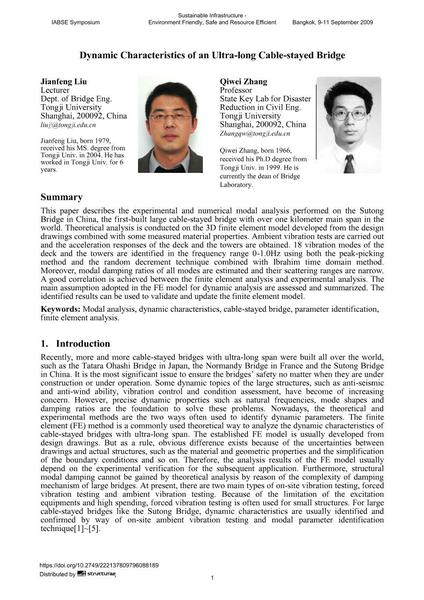Dynamic Characteristics of an Ultra-long Cable-stayed Bridge

|
|
|||||||||||
Bibliografische Angaben
| Autor(en): |
Jianfeng Liu
Qiwei Zhang |
||||
|---|---|---|---|---|---|
| Medium: | Tagungsbeitrag | ||||
| Sprache(n): | Englisch | ||||
| Tagung: | IABSE Symposium: Sustainable Infrastructure - Environment Friendly, Safe and Resource Efficient, Bangkok, Thailand, 9-11 September 2009 | ||||
| Veröffentlicht in: | IABSE Symposium Bangkok 2009 | ||||
|
|||||
| Seite(n): | 240-249 | ||||
| Anzahl der Seiten (im PDF): | 8 | ||||
| Jahr: | 2009 | ||||
| DOI: | 10.2749/222137809796088189 | ||||
| Abstrakt: |
This paper describes the experimental and numerical modal analysis performed on the Sutong Bridge in China, the first-built large cable-stayed bridge with over one kilometer main span in the world. Theoretical analysis is conducted on the 3D finite element model developed from the design drawings combined with some measured material properties. Ambient vibration tests are carried out and the acceleration responses of the deck and the towers are obtained. 18 vibration modes of the deck and the towers are identified in the frequency range 0-1.0Hz using both the peak-picking method and the random decrement technique combined with Ibrahim time domain method. Moreover, modal damping ratios of all modes are estimated and their scattering ranges are narrow. A good correlation is achieved between the finite element analysis and experimental analysis. The main assumption adopted in the FE model for dynamic analysis are assessed and summarized. The identified results can be used to validate and update the finite element model. |
||||
| Stichwörter: |
Schrägseilbrücke Finite-Elemente-Analyse Parameteridentifikation Modalanalyse
|
||||
